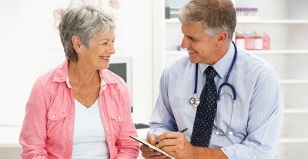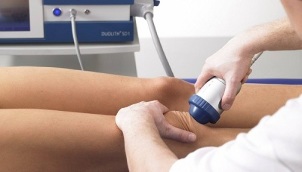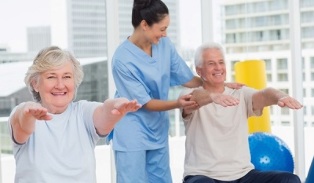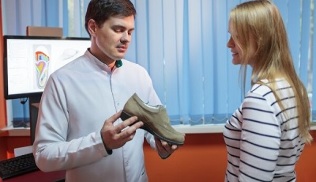
Arthrosis implies that they have joint damage and degenerative-dystrophic changes. This requires competent and timely treatment. This may involve a complex of conservative methods or may require surgical intervention. .
Arthrosis is a chronic disease of degenerative-dystrophic nature. It involves destruction of cartilage and disease changes in capsules, synovium, ligamentous apparatus and adjacent bone structures. Pathology requires an integrated approach to treatment.
medicine
One of the main areas of conservative treatment for arthrosis is the use of drugs. The following medicines are usually prescribed:
- Non-steroidal anti-inflammatory drugs. They give relief from inflammation, pain and fever.
- glucocorticosteroids. These drugs relieve inflammation and pain, but are more effective.
- pain medications. These include analgesics and some NSAIDs.
- Chondroprotectors. Such drugs are used in long courses. They are essential for the restoration of damaged cartilaginous structures.
- Muscle relaxants and antispasmodics. These drugs relieve pain by relieving muscle spasms.
- If arthrosis is the result of gout, then anti-gout medications are required.
- Vasodilator. Such drugs have vasodilating effect.
- Compressors are effective in treating arthrosis, for which medical bile and other means are used.
- Vitamin and mineral complexes. They are required to activate immunity, normalize material metabolism and metabolic processes, replenish missing elements and assimilate them. Calcium supplements are usually prescribed.
Individual choice of drugs is often inaccurate. The appropriate physician should prescribe the drugs and determine the characteristics of their use.
Physiotherapy
Arthrosis treatment usually involves various physiotherapy procedures. They are used as part of conservative therapy and are prescribed to accelerate recovery after surgery and reduce the risk of complications.
The following procedures are effective for arthrosis:

- laser therapy- exposure to heat to encourage regeneration;
- magnetotherapy- increase vascular tone, activate metabolic processes, accelerate recovery, relieve inflammation;
- ozokeritotherapy- warming to improve microcirculation and relieve pain;
- electrophoresis- administration of drugs via electric current;
- cryotherapy- exposure to low temperatures to reduce swelling, pain, reduce muscle tone;
- ultrasound- exposure to high frequency sound to improve material metabolism;
- UHF therapy- softening of calcium deposits, normalization of material metabolism, reduction in edema;
- homeosiniatry- introduction of homeopathic treatment in biologically active points.
There are differences in physiotherapy procedures. These include inflammatory processes, pregnancy, and expansion of active tuberculosis. There are also many restrictions for individual procedures.
massage
Massage is used in the treatment of arthrosis or in the epicenter period. In acute illness, such treatment is excluded, because affected joints require complete rest.
Massage provides the following effects for arthrosis:
- pain relief;
- return of mobility, elimination of rigidity;
- activation of blood circulation and lymphatic flow;
- prevention of muscle atrophy, strengthening of muscle corset;
- Improving metabolic processes and tissue trophism.
The characteristics of a massage depend on which joints are affected. In any case, such therapy should be performed exclusively by a qualified specialist. Before the massage, he must have a degree of mobility, muscle condition, Contraction, anilosis, pain points should be identified.
The effectiveness of massage is provided by its course application. The number of sessions is determined individually. Periodically, massage courses must be repeated - their frequency is also chosen on an individual basis. is.
exercise therapy
Physiotherapy is actively used for arthrosis. It is necessary to activate blood circulation and metabolic processes, restore joint mobility, and strengthen the muscle corset. In the early stages, exercise therapy is an instructor. Should be taken care of.
In the future, you can do gymnastics:

- Lie on your back on your surface and spread your legs. Bend one leg from the knee, keeping the foot at a height of 5–10 cm from the floor. In this position for 5 seconds. Fix, return to initial position. Alternately do 5 repetitions on each leg.
- The starting position is the same. Fold one leg and press it with your hands to the body. Fix for a few seconds. Then place your foot on the floor and slowly straighten the limb. 10-Do 15 repetitions.
- The starting position is the same. Raise your straight leg 25–30 cm above the floor and fix it for a few seconds. Return to the starting position. Do 20-30 repetitions on each leg in turn.
- Lie on your stomach. Bend your knees alternately, try to push your buttocks up to your heels, but without lifting your hips off the floor. Do 20-50 reps for each leg.
- The starting position is the same. Bend your knees alternately, fixing yourself for a few seconds at the climax. Do 10 reps for each leg.
- Sit with your back straight. Keeping a moderate pace, bend and rotate the legs alternately. In the future, you can exercise with a smaller weight.
- The starting position is the same. Raise your leg to form a right angle. Fix for 3 seconds and return to the starting position. Do 10 reps for each leg.
Osteoarthritis can affect different joints, therefore, the set of exercises must be specialized in each case. It should be developed by a specialist, taking into account the patient's individual characteristics and his disease.
All exercises should be performed smoothly, fast movements are excluded. It is necessary to monitor your breathing during gymnastics - it should be calm and measured.
lifestyle
Treatment of arthrosis includes some lifestyle changes:
- If you are overweight, you need to normalize it. This moment is especially important in case of damage to the lower ends.
- Moderate physical activity. High weights should be excluded, so you should not engage in professional sports. The best option is physiotherapy practice and regular walking.
- Attentive attitude towards your health status. Treatment of chronic diseases, periodic intake of vitamin-mineral complexes, preventive examinations by a doctor are necessary.
- The right choice of clothes and shoes. A person should not feel shy. Tight clothing is filled with stagnation of blood, which is dangerous with arthrosis. Women should avoid high heels, shoes stableShould be
- Correct organization of sleeping and working space. All furniture should be comfortable. It should provide a state of the body that does not slow down the blood circulation, which does not cause the organ to flow. If you have movement problems, Then you should equip your house with special handles and handrails.
diet
With arthrosis, proper nutrition is mandatory to follow. Dietary characteristics vary and depend on many factors.
General principles of nutrition are as follows:
- Partial nutrition. You need 5-6 meals per day, and portions should be small.
- Proper metabolism is ensured by adequate carbohydrates. The emphasis should be on complex carbohydrates - vegetables, fruits, berries, grains.
- elimination of simple carbohydrates - sugar, sweets.
- Vegetable fat is needed to speed up metabolic processes. For cooking, only one natural product is useful.
- To restore cartilaginous structures, it is useful to use jelly meat, jelly on a gelatin basis.
- For cooking, you need to limit yourself to cooking, stewing and cooking steam.
- Exclusion of spicy, salty, fatty, fried foods from the diet. Refusal of fatty meat, fast food, corn oil.
- Nutrition should be enriched with milk, cheese, other dairy and fermented milk products. They should be fat-free or low-fat.
- You need foods rich in zinc and magnesium - liver, fish, nuts, pumpkins, legumes.
- Oranges and bell peppers are good sources of antioxidants. To relieve inflammation, you need to use pomegranate, pineapple.
Special Orthopedic Instruments
In the treatment of arthrosis, various devices are often used to make life easier for the patient and reduce the risk of some complications.
The following constructions are used in orthopedics:

- Cane - used to redistribute the load in case of damage to the lower extremities. It is commonly used in the late stages of the disease, as well as after surgery.
- Orthos - used to heal joints. It allows you to reduce or adjust the mobility of the joint, gradually increasing it.
- Bandages - also used for healing joints, injuries, and benefits after operation.
- Corset - used to fix and straighten the trunk, mainly for hip joints.
- Heel Pad - Provide cushioning, reduce load.
- Flat foot correction, liner for foot relief.
- Corrective for deformed fingers.
- Silicon protectors to protect deformed fingers.
If arthrosis is caused by flat feet, orthopedic shoes and special insoles should be used. Such a measure is also necessary in case of damage to the lower extremities to reduce the risk of complications.
expansion of joints
This technique is called traction. It can be manual or hardware. Dinging is commonly used when the hip or knee joints are affected.
Traction refers to the application of the course. On average, 10-12 sessions are required. They can be done daily or every other day.
Joint expansion is a temporary measure and should be repeated periodically. With arthrosis, 2 courses are usually taken per year.
traditional medicine
The use of traditional medicine as an adjunct to treatment is appropriate.
The following prescription is effective for arthrosis:
- Compression with cabbage or horseradish leaves. Selected sheets must be washed or sliced in several places, applied to the affected area, fixed with foil and insulated. It leaves the leaf in honey. Dipping is also effective. Such a compress should be kept for several hours and performed several times a day.
- Mix equal parts iodine (5%), ammonia (10%), medical bile, glycerin and maybe honey. Mix the ingredients and place in a dark place for another week and a half. Before using, mixShake and heat the required amount in a water bath. Affect a napkin in the composition, apply to the affected area, fix with cellophane and insulate. Bake at night until you recover.
- Add half a glass of vodka to the root of 50 grams of dry encampen and leave for 2 weeks in the dark. Rub the sore joints with the resultant product.
- Make a thick mixture by mixing egg peels into powder, mixing with kefir. Wrap it in linen and attach it to the affected area, fix it with polyethylene and strengthen it. One compress each day and add 2Keep for 5 hours.
- Mix equal parts honey with glycerin, alcohol and iodine. Apply the mixture gently with a cotton pad, rising from the bottom to the top.
- Pour a handful of oats with half a liter of water and boil for 10 minutes. Apply hot on the affected area, fix with foil and insulate. Grasp one hour.
Natural remedies also have contraindications and side effects. Each new product must be used cautiously, with minimal dosage and duration of use.
Surgical treatment
Surgical intervention is necessary in case of severe pathological changes, development of serious complications, and ineffectiveness of conservative approaches.
Surgical treatment of arthrosis can be done in the following ways:
- arthroplasty- restoration of articular surfaces. Signal ankylosis, contractions may occur. Such an operation is possible only in the absence of an acute inflammatory process.
- arthrotomy- opening of the joint to remove a foreign body, endoprosthetics, purulent contents.
- Arthrodesis- Ankylosis (joint immobility) is artificially created. Operation can be intra- and extra-articular.
- affection- Partial or complete removal of the articular surface and synovium to create motion within the joint.
- Arthritis- creating conditions to limit joint mobility.
- Endoprosthetics- the appointment of a transplant for complete or partial replacement of the affected joint.
- periarticular osteotomy- filing bones and exposing them at a certain angle. This measure allows you to move your center of gravity and redistribute the load.
Arthrosis is a serious disease that causes irreversible changes. It is necessary to begin adequate treatment as soon as possible. It can be conservative or surgical and involves a range of different measures. Medical features of each patientAre determined on an individual basis.

















































